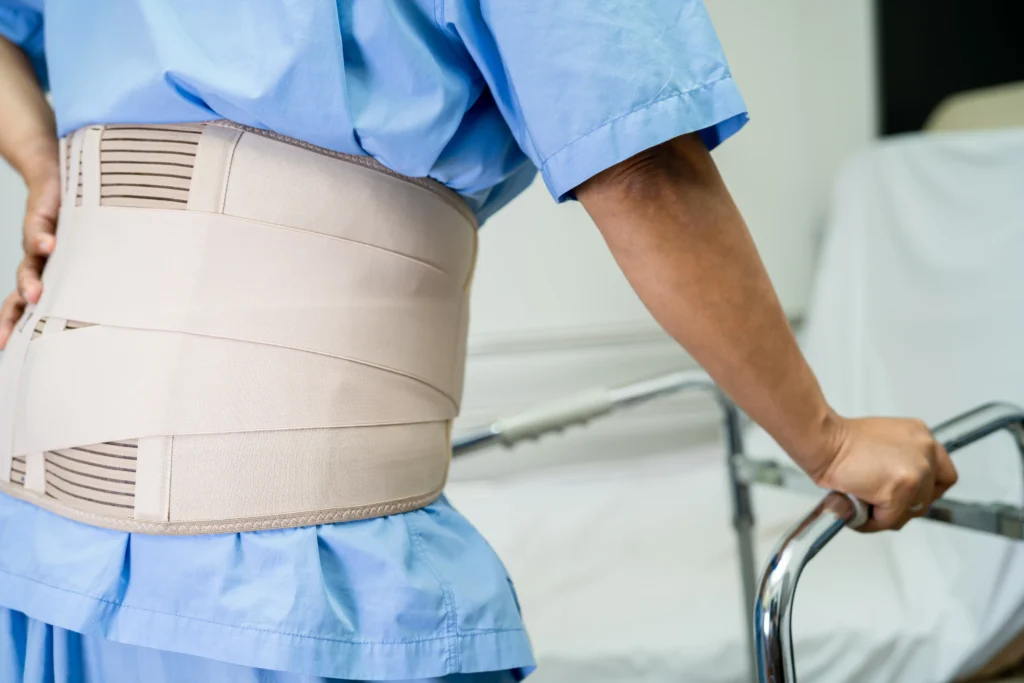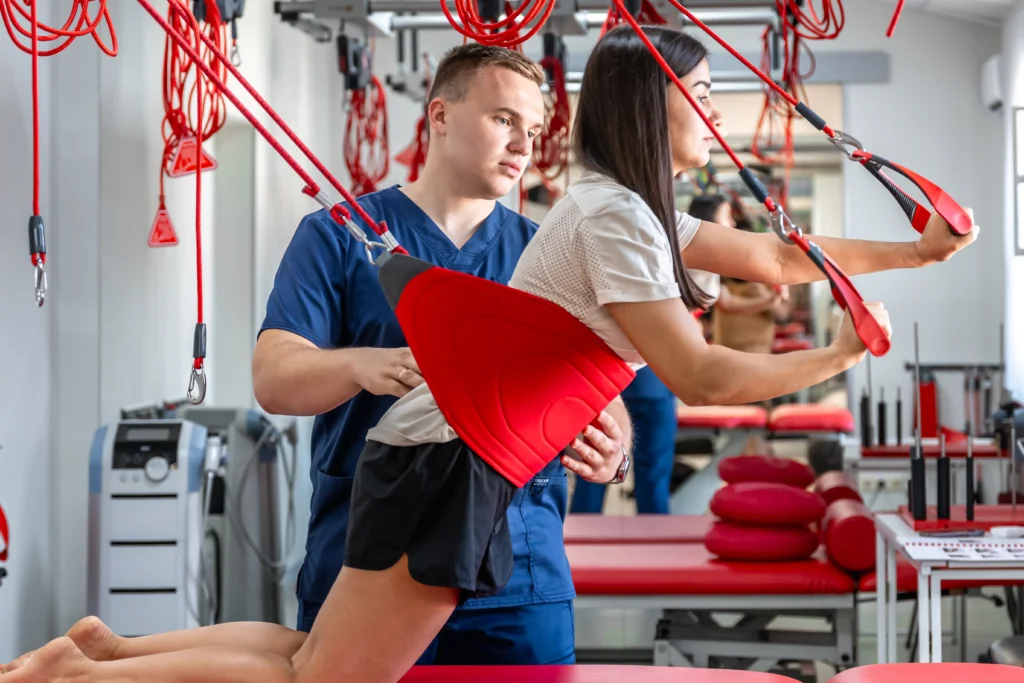
Table of Contents
ToggleSpinal fusion rods and screws are specialized tools used in spine surgery to stabilize and support the spine while it heals. When spinal bones need to be fused, these devices hold the vertebrae in place, ensuring proper alignment during recovery.
The rods are connected to screws that are anchored into the bones, creating a rigid structure to prevent movement. This setup allows the bone grafts between the vertebrae to heal into a single, solid bone.
Over my 25 years as a spine surgeon at Long Island Neuroscience Specialists, I’ve seen how advancements in these devices have transformed spinal fusion surgery. Modern rods and screws not only stabilize the spine but also improve recovery outcomes.
These tools are indispensable when addressing complex spinal conditions that compromise stability.

Spinal fusion rods and screws are often necessary when the spine loses its natural stability due to injury, disease, or degeneration. Conditions like scoliosis, where the spine curves abnormally, benefit significantly from this procedure.
The hardware corrects the curvature and holds the spine in place. Degenerative disc disease, where spinal discs wear down over time, is another common reason.
By fusing the vertebrae on either side of the damaged disc, rods and screws alleviate pain caused by instability. Spinal instability from trauma or severe arthritis also necessitates fusion surgery.
For patients with spondylolisthesis, where one vertebra slips forward over another, these devices provide the stability needed for proper alignment. In my practice, I’ve seen how patients with these conditions regain mobility and reduce pain with the help of spinal fusion rods and screws.
Modern spinal fusion rods and screws are made from advanced materials to ensure durability, safety, and compatibility with the human body. Titanium is the most commonly used material, prized for its lightweight nature and resistance to corrosion.
It’s also MRI-compatible, making post-surgery imaging simpler. Stainless steel, while durable and cost-effective, is heavier and less commonly used today due to its rigidity.
Cobalt chrome offers exceptional strength, particularly for patients requiring additional support. Materials like carbon fiber are emerging, offering flexibility and reducing interference with imaging.
These innovations represent the progress we’ve made in spine surgery technology. At Long Island Neuroscience Specialists, we use only the highest-quality materials tailored to each patient’s needs.
The choice of material often depends on the patient’s anatomy, the extent of the spinal condition, and the specific goals of the surgery.
The placement of spinal fusion rods and screws requires precision and expertise. Pedicle screws are inserted into the vertebrae’s pedicles, which are bony tubes that offer secure anchoring.
These screws are connected by rods, creating a frame that immobilizes the spine and supports the fusion process. Depending on the condition being treated, the surgeon may opt for a posterior approach (from the back), an anterior approach (from the front), or a combination of both.
At our practice, we use advanced imaging technology to ensure precise placement. This minimizes risks and improves outcomes.
The choice of approach depends on factors like the location of the spine requiring fusion and the severity of the condition. The versatility of rods and screws allows us to customize the procedure for each patient.

While spinal fusion surgery is generally safe, there are potential risks associated with rods and screws. Infection is a primary concern, but it is rare when proper surgical protocols are followed.
Hardware-related issues, such as loosening or breakage, can occur but are uncommon with modern materials and techniques. Nerve damage, though rare, is another potential complication due to the proximity of screws to spinal nerves.
One of the long-term risks is adjacent segment disease, where the unfused parts of the spine experience additional stress and wear. At Long Island Neuroscience Specialists, we take every precaution to minimize these risks, from pre-surgical planning to post-operative care.
Open communication with patients about potential risks ensures they feel informed and prepared.
Spinal fusion rods and screws are designed to last a lifetime in most cases. Titanium and cobalt chrome are highly durable materials that withstand the forces placed on the spine during daily activities.
However, there are rare instances where the hardware may need to be removed, such as when it causes discomfort or complications arise. Most patients can return to their normal routines without issue.
Over the years, I’ve followed up with countless patients who’ve experienced long-term relief and stability thanks to their spinal fusion hardware. Proper surgical technique and post-operative care are critical in ensuring the longevity of these devices.
Recovery from spinal fusion surgery can be challenging but is manageable with the right approach. Most patients stay in the hospital for 2-3 days after surgery, during which pain is managed, and mobility begins to be restored.
Once discharged, patients are advised to follow specific guidelines for wound care, activity restrictions, and physical therapy. Physical therapy plays a crucial role in recovery, helping patients regain strength and flexibility.
At-home exercises, combined with superviseda sessions, promote healing and prevent stiffness. Recovery can take several months, but most patients see significant improvements in pain and mobility over time. Read more here.

Not all patients with spinal conditions require spinal fusion rods and screws. Non-surgical treatments like physical therapy, chiropractic care, and spinal injections can effectively manage pain and improve mobility.
For some conditions, artificial disc replacement may be an option, preserving more natural motion than fusion. As a surgeon, I always prioritize conservative treatments before recommending surgery.
However, for patients with severe instability or deformity, spinal fusion remains the most reliable solution. Each patient’s journey is unique, and our goal is to provide the best possible care tailored to their needs. Read more here.
The field of spinal surgery is constantly evolving, with advancements in hardware technology leading to better outcomes. Robotic-assisted surgery allows for greater precision in placing rods and screws, reducing the risk of complications.
Materials like carbon fiber are enhancing the flexibility and compatibility of spinal implants. At Long Island Neuroscience Specialists, we stay at the forefront of these innovations.
By incorporating the latest technology into our practice, we ensure that our patients receive the highest standard of care. These advancements are transforming spinal fusion surgery, making it safer and more effective than ever before.
Preparation is key to a successful spinal fusion surgery. Patients should undergo a thorough evaluation, including imaging studies and lab tests.
Optimizing overall health through diet, exercise, and smoking cessation can improve recovery outcomes. It’s also essential to discuss medications with the healthcare team, as some may need to be paused before surgery.
On the day of surgery, patients can expect to be under general anesthesia. The process involves meticulous planning and execution to ensure optimal results.
We guide our patients through every step, from preparation to recovery, ensuring they feel confident and supported.

While rare, complications with spinal fusion hardware can occur. Symptoms like persistent pain, swelling, or changes around the surgical site may indicate a problem.
Numbness, tingling, or weakness in the limbs could also be a sign of hardware-related issues. Regular follow-up appointments and imaging studies are essential for monitoring the hardware’s performance.
At our practice, we encourage patients to report any concerns promptly. Early intervention can address potential issues before they become significant problems.
Before undergoing spinal fusion surgery, patients should feel empowered to ask questions. Common questions include:
At Long Island Neuroscience Specialists, we prioritize patient education and communication. By answering these questions thoroughly, we ensure that our patients feel confident and informed about their care.
Spinal fusion rods and screws are essential tools in modern spine surgery, providing stability and support for patients with a range of spinal conditions. From correcting severe deformities like scoliosis to stabilizing the spine after trauma or degeneration, these devices have transformed countless lives, enabling patients to regain mobility and reduce pain.
Over my 25 years as a spine surgeon at Long Island Neuroscience Specialists, I’ve seen firsthand the positive impact of advancements in spinal fusion hardware and surgical techniques. These tools allow us to address complex spinal issues with precision and confidence, tailoring treatments to each patient’s unique needs.
While the decision to undergo spinal fusion surgery can be daunting, education and preparation are key to achieving the best outcomes. By understanding the role of rods and screws, the surgical process, and the recovery journey, patients can feel empowered to make informed choices about their care.
GET IN TOUCH +
285 Sills Road
Building 5-6, Suite E
East Patchogue, NY 11772
(631) 475-5511
184 N. Belle Mead Road
East Setauket, NY 11733
(631) 675-6226
GET IN TOUCH +
285 Sills Road
Building 5-6, Suite E
East Patchogue, NY 11772
(631) 475-5511
184 N. Belle Mead Road
East Setauket, NY 11733
(631) 675-6226
SUBSCRIBE TO OUR NEWSLETTER +
Send us a Google review. Click this link and let us know how we did!
Review us on Yelp too.